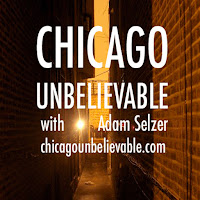 New Episode! Colonel Selig’s Moving Picture Plant 
|
Selig Polyscope Week is a collaborative effort between Chicago Unbelievable and White City Cinema – their first post of the week, is right here: The Secret History of Chicago Movies: Selig Polyscope. It provides a great overview of the history of Selig and his Chicago studio.
While Col. Selig made hundreds of movies at his Chicago studio, the best-remembered today is probably The Fairylogue and Radio Plays – even though it no longer exists. This was the first Wizard of Oz movie. It was not a movie (or radio play) in the traditional sense of the word – the “radio plays” were a series of short Oz-based movies that were hand colored and projected during L. Frank Baum’s touring show, during which he interacted with the movies. This show rolled into Chicago to play at Orchestra Hall in October, 1908. The mulitmedia show was years – decades, really – ahead of its time. However, while critics generally loved it, they didn’t seem to take much notice of it as being anything more than a childrens’ show. As the Tribune put in its review:
In the first place, they brought with them their creator, L. Frank Baum, who wore a lovely white frock coat and won the affections of a good sized audience of children and grownups. In the second place, they added two perfectly good new words – “fairylogue” and “radio-play” to the vocabulary of our already overworked press agents…. Baum himself had supervised the casting of the show and selected Romola Remus as Dorothy. In 1977, when she was living in Uptown “with a menagerie that includes several cats, a parrot, and 35-year-old Pete the Turtle,” she remembered the experience in an interview with the Tribune. “I was very young,” she said, “but remember my mother taking me to the studio that day and saying ‘It’s just another movie.’ I never would have dreamed that it would have amounted to anything more.” When asked if she regretted not moving to Hollywood with the rest of the movie industry a few years later, she said she didn’t. “What if I had made it as a star? It probably would have meant endless cocktail parties, which I think are boring because of all the phonies.” A couple of years earlier, she spoke about Baum and Selig: “The privilege of knowing Mr. Baum was a happy and rewarding experience for me. I, also, portrayed the role of Dorothy in the first ‘Wizard of Oz’ movie. I believe it was the very first colored moving picture. It was produced by Selig’s company. I remember Mr. Baum was always on hand offering encouragement or constructive criticism to all his workers. When the film was shown at various theatres, he would lecture about his various books. I recall some proud and joyous moments standing beside this tall, gentle, dignified gentleman on-stage after each matinee. The little children would clamor for his autograph, with cheers of joy!” Just about every researcher who looks up The Fairylogue winds up falling down a rabbit hole researching Romola Remus (later Romola Dunlap). Her father, George, became a bootlegger, ended up murdering a lover, and is sometimes said to be the inspiration for The Great Gatsby. In her later years, she often reminisced in newspapers about turn-of-the-century Chicago, once writing about meeting Robert Todd Lincoln with her father on Michigan Avenue. The Fairylogue clips to not survive. Some say that they were incorporated into a later Oz movie that Selig made the next year, after Baum went bankrupt touring with the show (it was successful, but too expensive to produce to make money), but this doesn’t appear to be the case. Like 99% of Selig movies, they are lost artifacts. Here is a still that circulates: Wikipedia entry on the Fairylogue |
Selig Polyscope week: The First Oz Movie
(Visited 534 times, 1 visits today)



The 1910 version of Oz (produced by Selig and directed by one Otis Turner) can be seen on youtube here:
http://www.youtube.com/watch?v=jpV29YZ7Ksw
It has its charm although Turner was no D.W. Griffith!